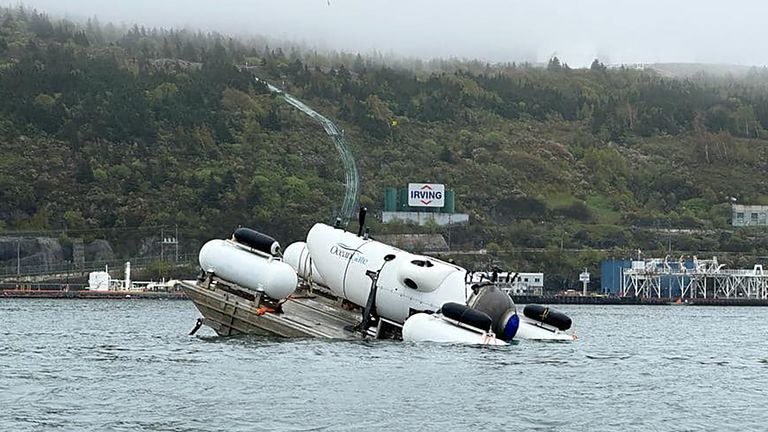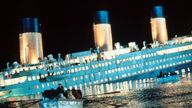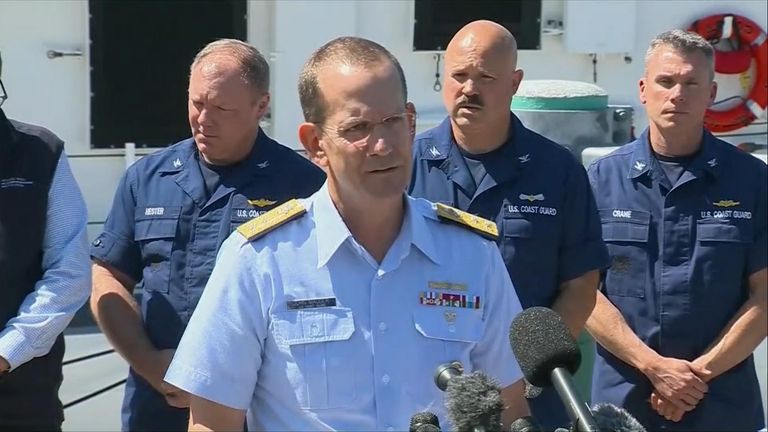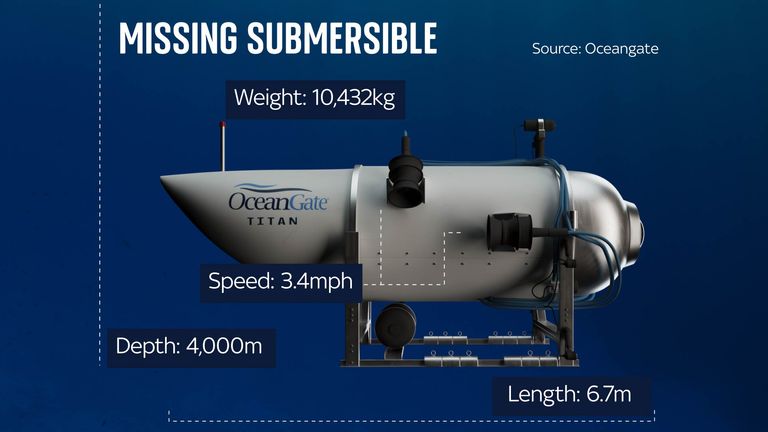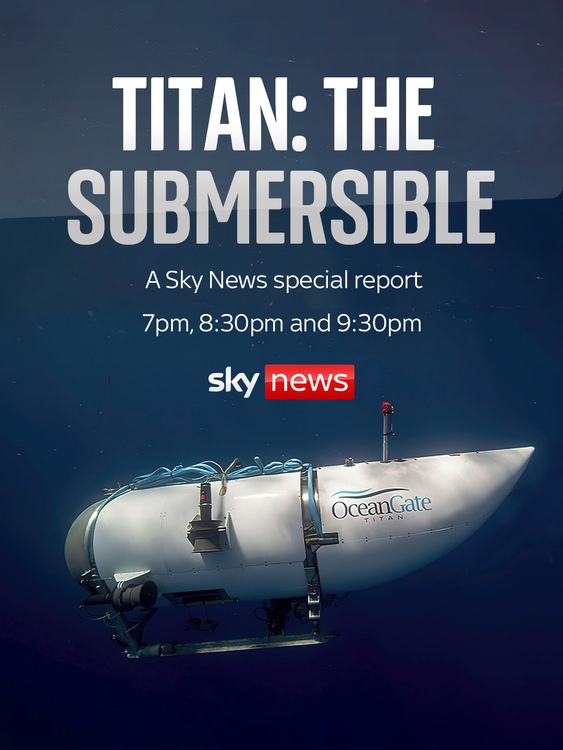Titanic submersible search: What happened to the Titan
Crews spent five frantic days trying to find the submersible and those on board. The breakthrough came when a deep-sea robot was deployed and discovered debris near the Titanic shipwreck.
Friday 23 June 2023 11:00, UK
After five frantic days of searching, "major pieces" of the Titan have been found near the Titanic wreck - with all five men who were on board the submersible presumed dead.
The US Coast Guard said the breakthrough was made by a remotely-operated vehicle (ROV) which had been scouring the ocean floor.
The deep-sea robot, which was sent below the waves by Canadian vessel Horizon Arctic, made the initial discovery on Thursday morning when it spotted the "tail cone" from the rear tip of the submersible.
It was found approximately 1,600ft (500 metres) from the bow of the Titanic's wreck.
Tributes paid to Titan passengers - live updates
Rear Admiral John Mauger told a news conference at Boston Harbour that the ROV then continued to explore the area and found further debris, including the front end of the pressure hull and later the other end.
He said that, in consultation with experts, it had been concluded that "the debris is consistent with the catastrophic loss of the pressure chamber.
"Upon this determination, we immediately notified the families... I offer my deepest condolences," he said.
In response to a question from Sky's James Matthews, officials revealed they ended up spotting "five different major pieces" of the vessel which allowed them to positively identify it as the Titan.
'Totality of the vessel' found
Following the tail cone discovery, the ROV then came across a large debris field nearby, officials said, where the front of the sub's pressure chamber was found.
This provided the "first indication there was a catastrophic event", said Paul Hankins, director of salvage operations in US Navy.
The robot then came across a second, smaller debris field, which contained the other end of the pressurised hold, which Mr Hankins said "basically compromised the totality of that pressure vessel".
Officials said ROVs would continue to search the area to "fully map out what's down there".
But they declined to be drawn on the prospects of recovering the bodies of those who died.
Rear Admiral John Mauger told reporters that it was an "incredibly unforgiving environment" and that the debris was "consistent with a catastrophic implosion of the vessel".
'Confident questions will be answered'
Expert Carl Hartsville, of the Woods Hole Oceanographic Institution, told the same news conference he had seen nothing to indicate that the sub had crashed into the Titanic or had imploded above it.
He said the debris field suggested the disaster had happened away from the Titanic in "the water column" - a term used to describe the space between the surface and ocean floor.
Mr Hartsville said the debris from the sub was found on a "smooth bottom" of the sea and there was "no wreckage [from the Titanic] in the area".
Rear Admiral Mauger said it was too early to tell when the Titan had imploded and said banging noises that were heard during the search do not appear to have been connected to the debris they found.
He said buoys to detect sound had been in the water for more than 72 hours and had not detected any "catastrophic events" during that time.
He added: "How, why, and when did this happen... are questions that we will collect as much information as we can now while governments are meeting and discussing what an investigation of this nature might look like.
"This is something that happened in a remote portion of the ocean... so it is a complex case to work through, but I'm confident those questions will begin to get answers."
How the search unfolded
The Titan began its two-hour descent to the wreck of the Titanic, at a depth of 3,810m (12,500ft), at around 8am local time (1pm UK time) on Sunday 18 June.
At 9.45am (5pm UK time), the sub lost contact with its surface vessel. Titan then failed to appear at its scheduled surface time of 3pm (8pm UK time).
But it was not until 5.40pm (10.40pm UK time) that the US Coast Guard was made aware.
Search begins
US and Canadian ships, and planes, officially began their search the next day, on Monday 19 June.
Sonobuoys, capable of monitoring sound at depths of up to around 3,900m (13,000ft), were dropped into the Atlantic in an attempt to pick up any sign of the missing craft.
'Banging noises'
As details emerged on Tuesday 20 June of who was on board, France committed to sending Atalante, a ship equipped with a deep-sea diving vessel, to the search area.
The urgency of the search was highlighted by information from the vessel's operator, OceanGate Expeditions, which said that Titan had a 96-hour oxygen supply in case of emergencies.
However, hopes were raised when reports emerged that sounds had been detected under the water across several hours.
No official announcement was made, despite US media outlets beginning to report the news.
Rescue race
The US Coast Guard confirmed on Wednesday 21 June that a Canadian P-3 aircraft detected underwater banging noises at 30-minute intervals, but added that the resulting search came back "negative".
The US Coast Guard, US Navy, Canadian Coast Guard and OceanGate Expeditions established a unified command to oversee search operations, with the French vessel Atalante arriving later in the evening. At least 10 vessels were involved by that point.
Officials estimated the supply of breathable air in the sub would run out at around 12.08pm UK time.
Be the first to get Breaking News
Install the Sky News app for free


Debris discovery
The estimated deadline for Titan's oxygen supply to run out was reached just after noon on Thursday 22 June. But the rear admiral leading the search and rescue operation told Sky News it remained "active" and that crews were "hopeful".
All vessels involved in the search were by then finally in place - including the Atalante ship, which brought a robot that can dive to 6,000m (19,600ft).
Just before 4.50pm (UK time), the US Coast Guard revealed that "a debris field was discovered within the search area by an ROV near the Titanic".
It added in a short statement that "experts within the unified command are evaluating the information".
Sky News then interviewed David Mearns, a rescue expert who knows two of the five men onboard.
While live on air, he received a WhatsApp message suggesting that the 'landing frame and rear cover' of the vessel had been discovered.
He said: "They don't use phrases like 'debris field' unless there's no chance of a recovery of the men alive.
"A debris field implies a break-up of the submersible... that really sort of indicates what is the worst-case scenario, which is a catastrophic failure and generally that's an implosion.
"The only saving grace is that it would have been immediate - literally in milliseconds - and the men wouldn't have known what was happening."
Just before 8pm UK time, OceanGate said in a statement it believed that those on board had "sadly been lost".
The company said it "grieved the loss of life" and expressed gratitude "for the countless men and women from multiple organisations of the international community who expedited wide-ranging resources and have worked so very hard on this mission".
